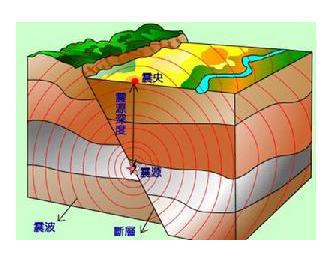Seismic origin: The place where an earthquake occurs within the earth.
Depth of seismic origin:Consider the seismic origin as a point,the vertical distance from this point to the ground, known as the focal depth.
Epicenter: The projection point of the seismic origin on the ground, known as the epicenter.
The meizoseismal area: The most severely damaged area on the ground.
The epicentral distance:The direct distance from the epicenter to any point on the ground.
Aftershock: a series of earthquakes after the main shock
Main earthquake type: Earthquake sequences with prominent main earthquakes
The swarm type of the earthquake: There are no prominent main earthquake, the main energy is released from multiple earthquakes of similar magnitude.
The isolation type of the earthquake:There were very few foreshocks or aftershocks,seismic energy was essentially released once by the main earthquake.
Seismic wave:Seismic waves are elastic waves that propagating the earth's medium from the seismic origin. Seismic waves are the only waves which known to penetrate the earth's interior.
When the earthquake occurs, the fracture and dislocation of underground release enormous energy, motivate an elastic wave and propagate all around, this is a seismic wave. Seismic waves from the seismic origin propagating to all directions through the earth's medium, therefore, we can record earthquakes by seismograph around the world. People's understanding of the earth's interior comes from seismic waves.

Seismic waves are mainly divided into body wave and surface wave. Body waves can propagate to any direction in three–dimension space, it can also be divided into longitudinal wave and shear wave. The longitudinal wave (also known as the P wave) means that the vibration direction is consistent with the wave propagation direction, we feel jolt when they reach the ground, objects bouncing up and down. The shear wave (as known as the S wave) means that the vibration direction is perpendicular to the wave propagation direction, we feel shaky when they reach the ground, objects swinging back and forth. The longitudinal waves travel faster than the shear waves inside the earth, so when an earthquake occurs, the longitudinal wave always reach the surface first. Then, when a major earthquake occurs, we feel jolt up and down first, a few seconds to a dozen seconds later, we feel a strong horizontal wobble. When the body wave reaches the rock layer interface or the earth's surface, it will create a border, or the earth surface propagates large range waves, as known as surface waves
The longitudinal wave is a propulsive wave, the propagation velocity in the crust is 5.5 ~ 7.0km/s, first arrival, which makes the ground vibrate up and down, less destructive. When the shear wave propagates, the particle’s motion direction is perpendicular to the shear wave’s direction of propagation, shear stress is produced in the medium, as known as the shear waves. Because the fluid cannot withstand shear stress, therefore, shear waves can only travel in solids, cannot travel in liquid or gas. The velocities of p-waves and s-waves are determined by the density and elastic constants of the medium. The propagation velocity of shear wave in the crust is 3.2 ~ 4.0km/s, second arrival, it makes the ground jitter before and after, left and right, more destructive. Surface waves are mixing waves, that stimulate the produce the waves by the longitudinal and shear waves meeting at the surface, the wave is long and big, has strong amplitude. Surface waves are elastic waves that travel along the surface of the earth, surface waves travel slower than body waves, it is the main factor that destructed the building strongly. There are two kinds of the most important surface waves; Rayleigh wave(R wave) and love wave (L wave), they were named for in honor of their discoverer, a British scientist, LordRayleigh and A.E.H.Love.
An important aspect of utilizing seismic waves is seismic exploration, the history of seismic exploration can goes back to the mid-19th century. Mallette measured the propagative velocity of the elastic waves in the earth's crust, according to utilize the artificially motivated seismic waves, during the first world war, both warring sides utilized seismic waves to locate each other's emplacement by the recoil from a heavy cannon, these are the seeds of seismic exploration. Because seismic exploration has precision and resolution which other geophysical prospecting methods cannot reach, so in the exploration of oil and other mineral resources, therefore, seismic wave is one of the most important and effective methods to explore oil and other mineral resources. All kinds of mineral resources have certain characteristics in structure, for example, petroleum and natural gas can only be formed and preserved in a certain closed structure. Seismic wave will produce reflection and refraction when it pass through these structures, according to analyze the signals which received on the surface, we can infer about the structure, depth and shape of the underground strata, therefore, it can provide accurate positioning for future drilling work.
The utilization of seismic waves can also serve national defense. Such as monitoring the underground nuclear explosions. Underground nuclear explosions will produce seismic waves as well as earthquakes, will leave a trail on the seismographic record in different regions. However, the recording waveforms of underground nuclear explosions and natural earthquakes are different, therefore, we can not only be distinguished from natural earthquakes and underground nuclear explosions by its waveform, but also can be given its time, location, energy, etc.
Comment list ( 0 )
